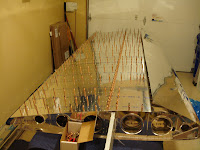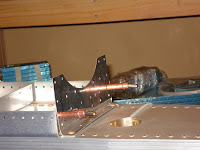




Clecoed and riveted top wiing skins onto left wing. The stiffening flange on the leading edge slipped into place with little persuasion. Greatest challenge was getting holes to line up to accept rivet. Plans very well written and most things are clear.
Moved onto the wing walk doubler. I was expecting difficulty with this as posted on Jerry's and Jim's blog, but following the plans and starting forward lower edge and working up and aft made things go pretty smoothly without the use of straps, etc. Some challenge in getting the holes to accept rivets after all clecoes in place, but used awl and eventually found it necessary to drill a few holes. Many time the hole looked to line up perfectly, but still would not let a rivet slip in. I did not want to force rivets so as not to deform the underlying rib. All went well and makes me worried that it was too easy!
Tomorrow I'll move on to installation of the access hatch and hand hold, etc.






 m for wings to be built simultaneously.)
m for wings to be built simultaneously.) he directions and attaching the terminal and ground wires to the W1205L using the screws and nuts called for, I discovered that the inventory indicated t
he directions and attaching the terminal and ground wires to the W1205L using the screws and nuts called for, I discovered that the inventory indicated t hat 2 MS21042-08 nuts were provided (and they were) but the plans require 3. Two for the W1205L and 1 for the W1205R. I will order another from Van's tomorrow.
hat 2 MS21042-08 nuts were provided (and they were) but the plans require 3. Two for the W1205L and 1 for the W1205R. I will order another from Van's tomorrow. ting. Some holes looked like the lined up perfectly but the rivet would not go in, even with gentle persuasion. I attempted to line them up using an awl with some success. Those that would not accept a rivet received a #30 drill visit. All went well and the W1201L inboard skin was installed before calling it a day.
ting. Some holes looked like the lined up perfectly but the rivet would not go in, even with gentle persuasion. I attempted to line them up using an awl with some success. Those that would not accept a rivet received a #30 drill visit. All went well and the W1201L inboard skin was installed before calling it a day.



































